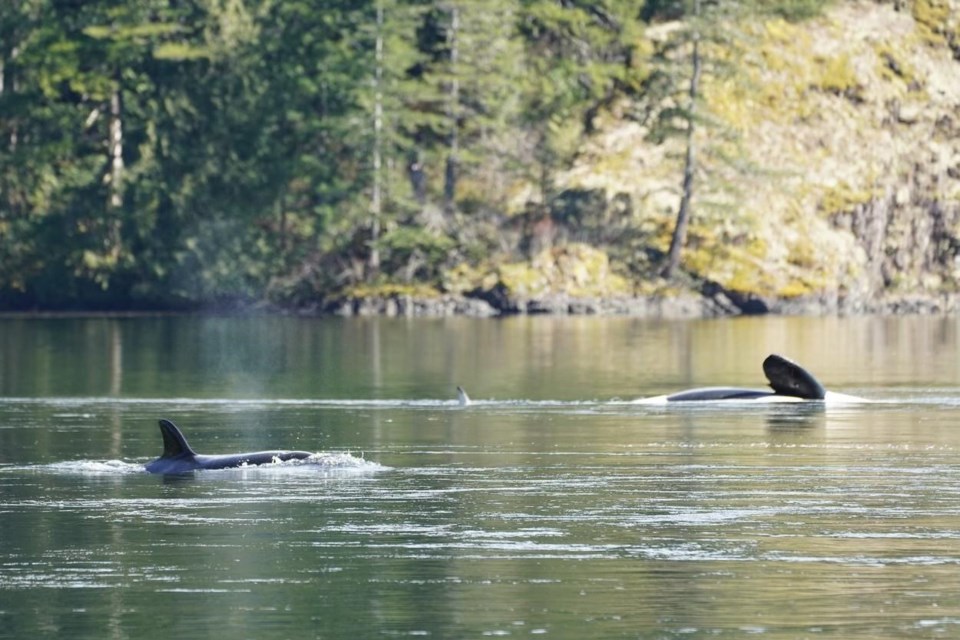ZEBALLOS, B.C. — A flotilla of up to 10 vessels, taking advantage of the best tidal flows in days, was on the waters of a remote lagoon off northern Vancouver Island Thursday in an effort to coax a young killer whale back to the open ocean, but "a successful outcome is not guaranteed."
Six days of efforts to entice a two-year-old orca calf out of the lagoon and back to the ocean following the death of its mother last weekend have included the use of recorded killer whale calls, specialized directional guide lines and the pounding of Indigenous drum beats, but with no success.
"This afternoon, Thursday, March 28, represents the best present opportunity for the whale calf to exit the lagoon as tides are not optimal over the next few days with the water becoming increasingly shallow," said a federal Fisheries Department statement. "Water levels are anticipated to improve after the weekend."
Rescue officials said earlier the tidal window at Little Espinosa Inlet is brief, just 30 minutes, which would allow the calf to swim out safely.
"The department would like to reiterate that this operation is highly complex, is unfolding in challenging weather, and in difficult geographic conditions," said the statement. "A successful outcome is not guaranteed."
Ehattesaht First Nation Chief Simon John said his people, who have deep spiritual and cultural connections to killer whales, are united in their goal of having the orca calf reunited with its extended family.
"It's hard to know what people are thinking when they watch the news and see us working here," he said in a statement. "All we know it that it is very hard and really emotional. This is day six and we know that time is short and there is a lot of pressure."
The lagoon is located near the remote village of Zeballos, more than 450 kilometres northwest of Victoria.
The Ehattesaht First Nation has given the young calf a name: kwiisahi?is, meaning Brave Little Hunter.
The community was planning a ceremonial dinner Thursday evening where the calf will be formally given its name, John said.
"Our council has also reminded everyone that we are working on the water in an emotional undertaking and we really need to think about safety of everyone," he said in the statement.
He said the community gathered for prayers and ceremonies Thursday to protect and provide guidance for its team and the young whale.
"It is important that we do these things as they help gather the strength everyone needs and send that strength to the young whale."
The calf faces difficult odds feeding itself and getting out of the lagoon without adult guidance, John said.
The young orca was likely still depending on its mother for milk and food, he said.
"We tried to gently move the young calf out of the lagoon and into Little Espinosa Inlet," said John. "Unfortunately, the sandbar at the causeway seems to remain a barrier and she is still there. The water is shallow across the bar at the entrance of the lagoon even at the moderate high tides."
The chief said the area is known as a prime seal hunting ground for killer whales, but it poses challenges, including 30-minute optimum tidal opportunities, to enter and exit the area.
The calf's mother died in the lagoon while local residents rushed to help her.
It's estimated she weighed up to 10 tonnes. A necropsy of the mother orca, a 15-year-old Bigg's killer whale, showed she was pregnant with a female fetus when she died.
Paul Cottrell, the Fisheries Department's Pacific region marine mammal co-ordinator, said the pregnancy may have contributed to the mother's death as she could not manoeuvre off the beach.
Cottrell said it's possible the orca calf could survive up to two weeks in the lagoon without eating.
The Fisheries Department statement Thursday said "trap-and-transport is one of the considerations on the table, however, it would not be utilized until other options have been exhausted due to its complexity and potential risks to the calf and the responders."
John said the rescuers are facing the difficult choice of feeding the calf to keep it alive, but then leaving it open to becoming habituated to being fed and not leaving the lagoon.
"We are mourning the loss of the mother and we are trying to help the young one to find her family," he said. "It really is something that rings home for native people. This loss and this struggle for the next generation."
— By Dirk Meissner in Victoria
This report by The Canadian Press was first published March 28, 2024.
The Canadian Press



